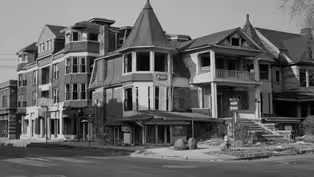Great Migrations: A People on The Move
How the Housing Crisis Impacted the Great Migration
Clip: Episode 3 | 4m 29sVideo has Closed Captions
Housing had always been inadequate in the Northern Black neighborhoods of the Great Migration.
Housing had always been inadequate in the Northern Black neighborhoods of the Great Migration but there were even more sinister forces at work: government policies that sought to keep neighborhoods segregated by race – or destroy Black neighborhoods altogether.
Problems playing video? | Closed Captioning Feedback
Problems playing video? | Closed Captioning Feedback
Corporate support for GREAT MIGRATIONS: A PEOPLE ON THE MOVE is provided by Bank of America, Ford Motor Company and Johnson & Johnson. Major support is provided by the Corporation...
Great Migrations: A People on The Move
How the Housing Crisis Impacted the Great Migration
Clip: Episode 3 | 4m 29sVideo has Closed Captions
Housing had always been inadequate in the Northern Black neighborhoods of the Great Migration but there were even more sinister forces at work: government policies that sought to keep neighborhoods segregated by race – or destroy Black neighborhoods altogether.
Problems playing video? | Closed Captioning Feedback
How to Watch Great Migrations: A People on The Move
Great Migrations: A People on The Move is available to stream on pbs.org and the free PBS App, available on iPhone, Apple TV, Android TV, Android smartphones, Amazon Fire TV, Amazon Fire Tablet, Roku, Samsung Smart TV, and Vizio.
Buy Now
Providing Support for PBS.org
Learn Moreabout PBS online sponsorshipThe quality of housing in black neighborhoods had been inadequate since the beginning of the Great Migration.
But by the 1960s, it had reached a state of crisis.
People were living in homes with broken windows, no heat, and with infestations of rats and roaches.
But it wasn't just unscrupulous landlords or the disappearance of factory jobs keeping people in this desperate state.
There were even more cynical forces at work.
A lot of people who are trying to stop the so-called white exodus to the suburbs say that their biggest problem is changing the attitudes of the people.
Do you feel that your attitude could be changed to make you want to stay here and live among Blacks?
Well, I don't know.
I mean, I'm not prejudiced.
I'd just as soon, you know, live here to live anywhere else, but I don't wanna be the only white family living here.
You see what I mean?
One of the greatest migrations of the 20th century was the migration of whites from central cities to surrounding suburbs.
This was a migration made possible by massive federal subsidies.
The process was totally closed or almost totally closed to Blacks.
It was the federal government that was actually promoting racial segregation in housing through what they called redlining.
The government did not like seeing Black and white people living together.
Black people were denied federal mortgages that they should have been entitled to.
So redlining helps to create an urban landscape that is rigidly segregated.
It becomes this sort of vicious cycle where most Black transplants to the north were stuck living in cities at a time when the tax base was declining, and the cities lacked the money to ensure that housing was decent and that the streets were safe.
Not only were racist government policies making it hard for Black people to live outside the city, they were also making it hard for them to live in the city.
In an effort to address urban decay, many cities began massive construction projects, razing old buildings, ostensibly to clear the way for new developments.
This was known in euphemism as urban renewal.
Urban renewal may have had a positive intention.
We're going to tear down the slums, and in some cases it did tear down slum housing.
But the way it went about doing that, it displaced so many people with little concern about the communities that lived there.
African Americans won't be welcomed back in this neighborhood once it's destroyed.
So the idea of urban renewal sounds like you're gonna fix something up so that the people will have a better place to live.
But it's being fixed up for a whole new set of people, not the people who are already there.
Most northern cities now are engaged in something called urban renewal, which means moving the Negroes out, It means Negro removal.
That is what it means.
And the federal government is an accomplice to this fact.
Many urban renewal projects destroyed traditional Black communities.
Particularly hard hit was Detroit's Black Bottom.
In the Lower East side of the city of Detroit was a neighborhood known as Black Bottom.
It was the primary residential neighborhood for African Americans all during the Great migration.
Just north of this Black Bottom residential area was a neighborhood known as Paradise Valley, which from the 1920s up until the 1960s was the entertainment and business district that was primarily owned by African American business people.
But Paradise Valley, which had been the center of Black business in Detroit since the first great migration was almost entirely destroyed for the construction of a major freeway.
Urban renewal gutted the capital of a whole generation of fragile but important Black-owned businesses.
Video has Closed Captions
Clip: Ep3 | 2m 38s | The 1967 Detroit uprising was one of the most violent of the 20th century. (2m 38s)
Providing Support for PBS.org
Learn Moreabout PBS online sponsorshipSupport for PBS provided by:
Corporate support for GREAT MIGRATIONS: A PEOPLE ON THE MOVE is provided by Bank of America, Ford Motor Company and Johnson & Johnson. Major support is provided by the Corporation...
















